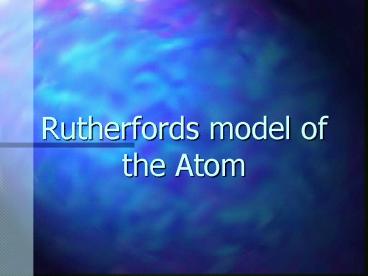Rutherfords model of the Atom - PowerPoint PPT Presentation
1 / 12
Title:
Rutherfords model of the Atom
Description:
He was professor of physics at McGill University in Montr al, Quebec, from 1898 ... of Cambridge and also held a professorship, after 1920, at the Royal Institution ... – PowerPoint PPT presentation
Number of Views:2272
Avg rating:3.0/5.0
Title: Rutherfords model of the Atom
1
Rutherfords model of the Atom
2
People in the group
- Jordan Neil
- Erin Isnor
- Heather Pickford
- Daniel Deines
- Leanne Myers
3
Ernest Rutherford
4
Ernest Rutherford1st Baron Rutherford of Nelson
and Cambridge(1871-1937)
Ernest Rutherford, British physicist, who became
a Nobel laureate for his pioneering work in
nuclear physics and for his theory of the
structure of the atom. Rutherford was born on
August 30, 1871, in Nelson, New Zealand, and was
educated at the University of New Zealand and the
University of Cambridge. He was professor of
physics at McGill University in Montréal, Quebec,
from 1898 to 1907 and at the University of
Manchester in England during the following 12
years. After 1919 he was professor of
experimental physics and director of the
Cavendish Laboratory at the University of
Cambridge and also held a professorship, after
1920, at the Royal Institution of Great Britain
in London.
5
His famous experiment
- In 1911 Ernest Rutherford thought it would
prove interesting to bombard atoms with alpha
rays, figuring that this experiment could
investigate the inside of the atom (sort of like
a probe). He used Radium as the source of the
alpha particles and shinned them onto the atoms
in gold foil. Behind the foil sat a fluorescent
screen for which he could observe the alpha
particles impact.
6
What was supposed to happen?
7
- The results of the experiments came
unexpected. Most of the alpha particles went
smoothly through the foil. Only an occasional
alpha veered sharply from its original path,
sometimes bouncing straight back from the foil. - Rutherford reasoned that they must get
scattered by tiny bits of positively charged
matter. - Most of the space around these positive
centers had nothing in them. He thought that the
electrons must exist somewhere within this empty
space.
8
- Rutherford thought that the negative electrons
orbited a positive center in a manner like the
solar system where the planets orbit the sun.
9
What does he know..
- Rutherford knew that atoms consist of a compact
positively charged nucleus, around which
circulate negative electrons at a relatively
large distance. - The nucleus occupies less than one thousand
million millionth of the atomic volume, but
contains almost all of the atom's mass. If an
atom had the size of the earth, the nucleus would
have the size of a football stadium.
10
What Confronted Rutherford?
- Ernest Rutherford had been studying alpha
particles since 1898. In fact, he discovered
them. - To him, alpha particles were part of the family.
In 1909 he was confronted with some rather
bizarre alpha-particle behavior that he had to
explain. What was the behavior, exactly?
11
- Hans Geiger and Ernest Marsden aimed a stream of
alpha particles at a thin gold foil for several
months in 1909. (They would continue studying
scattering until 1913.) Geiger cites a thickness
of 8.6 x 106 cm. for the foil. In fact, the foil
was so thin that it had to be supported on a
glass plate. (The plate without any foil was
studied and no deflections were found. It was
transparent to the alpha particles.) There were
three major findings
12
(No Transcript)































